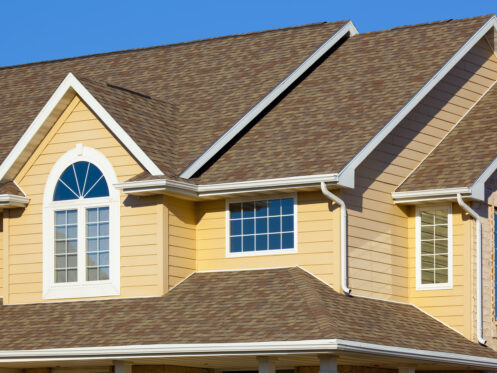Did you know that replacing a roof can be more involved than it seems at first glance? It’s true! That’s why the cost of a roof replacement can vary so much from one project to another.
Whether you’re thinking about updating your home’s roof or upgrading the one on your commercial building, it’s important to consider a few key factors that can affect the overall cost. Let’s explore these together!
Roofing Materials and All Other Roof System Components
One of the biggest factors that will affect the total cost of a roof replacement is the type of roofing materials used. Architectural asphalt shingles are the most common choice for residential roofs since they are fairly durable and also quite a bit less expensive per square foot compared to other materials like metal roofing, composite shingles, and especially clay or slate roof tiles.
Some roofing manufacturers also still produce the older style three-tab asphalt shingles. While these cost quite a bit less than architectural shingles, they’re seldom used nowadays since they aren’t very strong and typically only last for around 15 years. If you choose to opt for something like impact-resistant or high wind-resistant asphalt shingles, you’ll also pay quite a bit more compared to the basic architectural shingles.
When considering the total cost of a roof replacement, you also need to factor in all of the other roof system components. This includes things like the underlayment, drip edge, roof flashing, water and ice shield, roof vents and ridge caps. It usually isn’t necessary to remove the gutters when replacing a roof as long as they are still in good shape. However, it will be necessary to temporarily remove the gutters if the fascia along the edges of the roof is in poor condition and needs to be replaced.
Condition of Existing Roof
If your roof is still in mostly good condition other than the shingles or other roofing materials, replacing it will be a fairly straightforward task and will take less time than a roof in poor condition. Replacing some or all of the wooden roof sheets or roof decking can add to the overall cost, especially considering the high cost of lumber. If any parts of the roof are sagging or the roof decking is rotten, the roofers will also have to take extra precautions to work on it safely without the risk of falling through.
Unfortunately, it’s not always possible to determine whether or not any of the decking needs to be replaced until they’ve torn off the old roofing materials. Experienced roofers may sometimes be able to estimate the condition of the decking by going into the attic and looking at the undersides of the wooden sheets. Nonetheless, they usually won’t be able to accurately determine how much of the decking needs replacement until they’ve finished the initial tear-off.
Roof Size, Type and Slope
The size or total square footage of the roof is one significant factor in how much it will cost to replace. Most roofing contractors base their estimates primarily on square footage and the type of roofing materials used. However, the type of roof and how complex it is can also play an important role in the total replacement cost.
Replacing a basic gable roof tends to be much easier compared to a roof with numerous peaks, angles, and valleys or any other more atypical designs. Hip roofs are also often more expensive to replace compared to gable roofs since they have four faces instead of just two.
The pitch or slope of the roof is another major factor. Roofs with a lower slope generally cost less to replace since they are easier to move around on. Replacing a roof with a steep pitch will always take more time and be more expensive due to the increased labor costs. With a steep pitch, the roofers will need to add some sort of bracing onto the roof to support themselves. They’ll also need to use harnesses and other safety equipment to ensure they won’t fall off, and all of these factors can add to the total cost.
Commercial buildings with a flat roof are easy to walk on and not that difficult to replace. However, many such buildings have their HVAC system and potentially other equipment on the roof. These sorts of things can increase the time and cost of the replacement since the roofers will have to work around them and also take extra precautions to ensure they don’t get damaged.
Total Number of Roof Penetrations
All roofs have at least a few penetrations, which are anything that sticks up through the roof. This commonly includes things like the plumbing vent pipe, chimneys or exhaust flues, bathroom and kitchen exhaust vents and skylights. The more penetrations a roof has, the more complex replacing it will be and the more it will cost.
When replacing a roof, the roofers will have to use flashing and sealant to seal around all of the intrusions to ensure water can’t leak in around any of them. Sealing around vents and pipes is fairly easy and doesn’t add much time to the job, but installing the flashing and then the roofing materials around larger penetrations like chimneys and skylights can sometimes take quite a bit more time.
Height and Accessibility
Replacing a roof on a single-story home or commercial building also takes less time compared to a multi-story building where the roofers have to work higher off the ground. This is simply because the roofers will have to take additional safety precautions and usually end up working more slowly when working much higher up.
How easily accessible the roof is can also make a major difference in the total time and cost of the replacement. If you have things like a patio just underneath the roof or lots of landscaping just below it, it can make some parts of the roof more difficult to access. The roofers will also have to take additional precautions and use tarps and sometimes wooden sheets or boards to protect any nearby features, including the landscaping, patio and air conditioner.
Roofers will often use a boom lift to put all of the shingles or roofing materials on the roof. If the roof isn’t easily accessible from the driveway or yard, the job will likely be more expensive. In this case, they may need to use a lift with a longer extendable boom or even lift or carry everything up by hand. When tearing off the old roof, it’s also usually necessary to have a large roll-off dumpster or dump truck on site to dispose of all the old materials. If the dumpster or truck can’t be parked right next to the roof, the job will also take longer since the roofers will usually need to toss all of the old materials on the ground and then pick everything up and put it in the dumpster or truck.
Your San Antonio Roof Replacement Experts
Since 1946, BELDON Roofing Company has been helping customers in the San Antonio area with all of their roofing, gutter, window and siding needs. We work on residential and commercial roofs, and we only install roofing materials from top brands like Owens Corning and GAF. We always strive to complete all replacement jobs as quickly as possible and provide a full 10-year labor warranty on all roof replacements.
To schedule an inspection or to receive a quote on your roof replacement, contact BELDON Roofing Company today.

